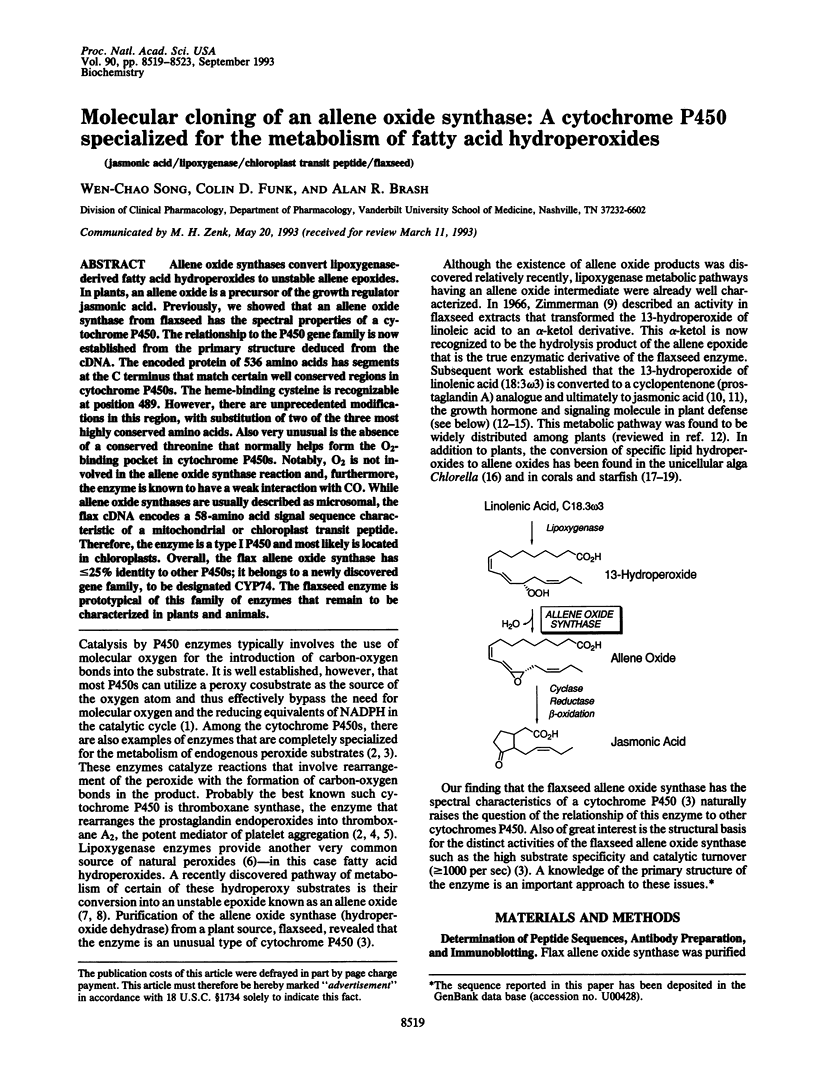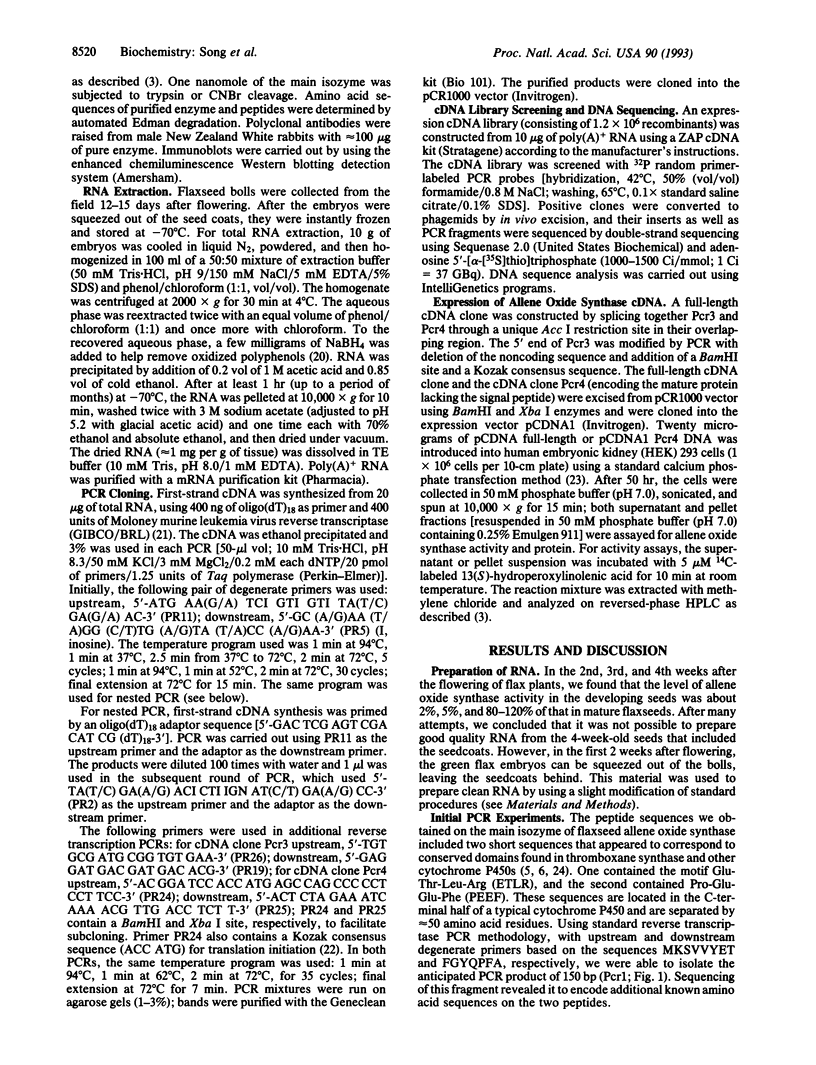Abstract
Allene oxide synthases convert lipoxygenase-derived fatty acid hydroperoxides to unstable allene epoxides. In plants, an allene oxide is a precursor of the growth regulator jasmonic acid. Previously, we showed that an allene oxide synthase from flaxseed has the spectral properties of a cytochrome P450. The relationship to the P450 gene family is now established from the primary structure deduced from the cDNA. The encoded protein of 536 amino acids has segments at the C terminus that match certain well conserved regions in cytochrome P450s. The heme-binding cysteine is recognizable at position 489. However, there are unprecedented modifications in this region, with substitution of two of the three most highly conserved amino acids. Also very unusual is the absence of a conserved threonine that normally helps form the O2-binding pocket in cytochrome P450s. Notably, O2 is not involved in the allene oxide synthase reaction and, furthermore, the enzyme is known to have a weak interaction with CO. While allene oxide synthases are usually described as microsomal, the flax cDNA encodes a 58-amino acid signal sequence characteristic of a mitochondrial or chloroplast transit peptide. Therefore, the enzyme is a type I P450 and most likely is located in chloroplasts. Overall, the flax allene oxide synthase has < or = 25% identity to other P450s; it belongs to a newly discovered gene family, to be designated CYP74. The flaxseed enzyme is prototypical of this family of enzymes that remain to be characterized in plants and animals.
Full text
PDF




Images in this article
Selected References
These references are in PubMed. This may not be the complete list of references from this article.
- Aoyama T., Yamano S., Waxman D. J., Lapenson D. P., Meyer U. A., Fischer V., Tyndale R., Inaba T., Kalow W., Gelboin H. V. Cytochrome P-450 hPCN3, a novel cytochrome P-450 IIIA gene product that is differentially expressed in adult human liver. cDNA and deduced amino acid sequence and distinct specificities of cDNA-expressed hPCN1 and hPCN3 for the metabolism of steroid hormones and cyclosporine. J Biol Chem. 1989 Jun 25;264(18):10388–10395. [PubMed] [Google Scholar]
- Bozak K. R., Yu H., Sirevåg R., Christoffersen R. E. Sequence analysis of ripening-related cytochrome P-450 cDNAs from avocado fruit. Proc Natl Acad Sci U S A. 1990 May;87(10):3904–3908. doi: 10.1073/pnas.87.10.3904. [DOI] [PMC free article] [PubMed] [Google Scholar]
- Brash A. R., Baertschi S. W., Ingram C. D., Harris T. M. On non-cyclooxygenase prostaglandin synthesis in the sea whip coral, Plexaura homomalla: an 8(R)-lipoxygenase pathway leads to formation of an alpha-ketol and a Racemic prostanoid. J Biol Chem. 1987 Nov 25;262(33):15829–15839. [PubMed] [Google Scholar]
- Brash A. R., Hughes M. A., Hawkins D. J., Boeglin W. E., Song W. C., Meijer L. Allene oxide and aldehyde biosynthesis in starfish oocytes. J Biol Chem. 1991 Dec 5;266(34):22926–22931. [PubMed] [Google Scholar]
- Briggs M. S., Gierasch L. M. Molecular mechanisms of protein secretion: the role of the signal sequence. Adv Protein Chem. 1986;38:109–180. doi: 10.1016/s0065-3233(08)60527-6. [DOI] [PubMed] [Google Scholar]
- Enyedi A. J., Yalpani N., Silverman P., Raskin I. Signal molecules in systemic plant resistance to pathogens and pests. Cell. 1992 Sep 18;70(6):879–886. doi: 10.1016/0092-8674(92)90239-9. [DOI] [PubMed] [Google Scholar]
- Farmer E. E., Ryan C. A. Interplant communication: airborne methyl jasmonate induces synthesis of proteinase inhibitors in plant leaves. Proc Natl Acad Sci U S A. 1990 Oct;87(19):7713–7716. doi: 10.1073/pnas.87.19.7713. [DOI] [PMC free article] [PubMed] [Google Scholar]
- Guengerich F. P. Reactions and significance of cytochrome P-450 enzymes. J Biol Chem. 1991 Jun 5;266(16):10019–10022. [PubMed] [Google Scholar]
- Gundlach H., Müller M. J., Kutchan T. M., Zenk M. H. Jasmonic acid is a signal transducer in elicitor-induced plant cell cultures. Proc Natl Acad Sci U S A. 1992 Mar 15;89(6):2389–2393. doi: 10.1073/pnas.89.6.2389. [DOI] [PMC free article] [PubMed] [Google Scholar]
- Hamberg M., Gardner H. W. Oxylipin pathway to jasmonates: biochemistry and biological significance. Biochim Biophys Acta. 1992 Nov 11;1165(1):1–18. doi: 10.1016/0005-2760(92)90069-8. [DOI] [PubMed] [Google Scholar]
- Haniu M., Armes L. G., Yasunobu K. T., Shastry B. A., Gunsalus I. C. Amino acid sequence of the Pseudomonas putida cytochrome P-450. II. Cyanogen bromide peptides, acid cleavage peptides, and the complete sequence. J Biol Chem. 1982 Nov 10;257(21):12664–12671. [PubMed] [Google Scholar]
- Hecker M., Ullrich V. On the mechanism of prostacyclin and thromboxane A2 biosynthesis. J Biol Chem. 1989 Jan 5;264(1):141–150. [PubMed] [Google Scholar]
- Heilmann L. J., Sheen Y. Y., Bigelow S. W., Nebert D. W. Trout P450IA1: cDNA and deduced protein sequence, expression in liver, and evolutionary significance. DNA. 1988 Jul-Aug;7(6):379–387. doi: 10.1089/dna.1.1988.7.379. [DOI] [PubMed] [Google Scholar]
- Joshi C. P. An inspection of the domain between putative TATA box and translation start site in 79 plant genes. Nucleic Acids Res. 1987 Aug 25;15(16):6643–6653. doi: 10.1093/nar/15.16.6643. [DOI] [PMC free article] [PubMed] [Google Scholar]
- Kalb V. F., Loper J. C. Proteins from eight eukaryotic cytochrome P-450 families share a segmented region of sequence similarity. Proc Natl Acad Sci U S A. 1988 Oct;85(19):7221–7225. doi: 10.1073/pnas.85.19.7221. [DOI] [PMC free article] [PubMed] [Google Scholar]
- Kizawa H., Tomura D., Oda M., Fukamizu A., Hoshino T., Gotoh O., Yasui T., Shoun H. Nucleotide sequence of the unique nitrate/nitrite-inducible cytochrome P-450 cDNA from Fusarium oxysporum. J Biol Chem. 1991 Jun 5;266(16):10632–10637. [PubMed] [Google Scholar]
- Kozak M. The scanning model for translation: an update. J Cell Biol. 1989 Feb;108(2):229–241. doi: 10.1083/jcb.108.2.229. [DOI] [PMC free article] [PubMed] [Google Scholar]
- Lau S. M., Harder P. A., O'Keefe D. P. Low carbon monoxide affinity allene oxide synthase is the predominant cytochrome P450 in many plant tissues. Biochemistry. 1993 Mar 2;32(8):1945–1950. doi: 10.1021/bi00059a010. [DOI] [PubMed] [Google Scholar]
- Ohashi K., Ruan K. H., Kulmacz R. J., Wu K. K., Wang L. H. Primary structure of human thromboxane synthase determined from the cDNA sequence. J Biol Chem. 1992 Jan 15;267(2):789–793. [PubMed] [Google Scholar]
- Porter T. D., Coon M. J. Cytochrome P-450. Multiplicity of isoforms, substrates, and catalytic and regulatory mechanisms. J Biol Chem. 1991 Jul 25;266(21):13469–13472. [PubMed] [Google Scholar]
- Roise D., Schatz G. Mitochondrial presequences. J Biol Chem. 1988 Apr 5;263(10):4509–4511. [PubMed] [Google Scholar]
- Song W. C., Brash A. R. Purification of an allene oxide synthase and identification of the enzyme as a cytochrome P-450. Science. 1991 Aug 16;253(5021):781–784. doi: 10.1126/science.1876834. [DOI] [PubMed] [Google Scholar]
- Su X., Gibor A. A method for RNA isolation from marine macro-algae. Anal Biochem. 1988 Nov 1;174(2):650–657. doi: 10.1016/0003-2697(88)90068-1. [DOI] [PubMed] [Google Scholar]
- Teunissen Y., Geraerts W. P., van Heerikhuizen H., Planta R. J., Joosse J. Molecular cloning of a cDNA encoding a member of a novel cytochrome P450 family in the mollusc Lymnaea stagnalis. J Biochem. 1992 Aug;112(2):249–252. doi: 10.1093/oxfordjournals.jbchem.a123885. [DOI] [PubMed] [Google Scholar]
- Vetter H. P., Mangold U., Schröder G., Marner F. J., Werck-Reichhart D., Schröder J. Molecular Analysis and Heterologous Expression of an Inducible Cytochrome P-450 Protein from Periwinkle (Catharanthus roseus L.). Plant Physiol. 1992 Oct;100(2):998–1007. doi: 10.1104/pp.100.2.998. [DOI] [PMC free article] [PubMed] [Google Scholar]
- Vick B. A., Zimmerman D. C. Metabolism of Fatty Acid Hydroperoxides by Chlorella pyrenoidosa. Plant Physiol. 1989 May;90(1):125–132. doi: 10.1104/pp.90.1.125. [DOI] [PMC free article] [PubMed] [Google Scholar]
- Vick B. A., Zimmerman D. C. Pathways of Fatty Acid hydroperoxide metabolism in spinach leaf chloroplasts. Plant Physiol. 1987 Dec;85(4):1073–1078. doi: 10.1104/pp.85.4.1073. [DOI] [PMC free article] [PubMed] [Google Scholar]
- Vick B. A., Zimmerman D. C. The biosynthesis of jasmonic acid: a physiological role for plant lipoxygenase. Biochem Biophys Res Commun. 1983 Mar 16;111(2):470–477. doi: 10.1016/0006-291x(83)90330-3. [DOI] [PubMed] [Google Scholar]
- Yamamoto S. Mammalian lipoxygenases: molecular structures and functions. Biochim Biophys Acta. 1992 Oct 30;1128(2-3):117–131. doi: 10.1016/0005-2760(92)90297-9. [DOI] [PubMed] [Google Scholar]
- Yokoyama C., Miyata A., Ihara H., Ullrich V., Tanabe T. Molecular cloning of human platelet thromboxane A synthase. Biochem Biophys Res Commun. 1991 Aug 15;178(3):1479–1484. doi: 10.1016/0006-291x(91)91060-p. [DOI] [PubMed] [Google Scholar]
- Zimmerman D. C. A new product of linoleic acid oxidation by a flaxseed enzyme. Biochem Biophys Res Commun. 1966 May 25;23(4):398–402. doi: 10.1016/0006-291x(66)90740-6. [DOI] [PubMed] [Google Scholar]



